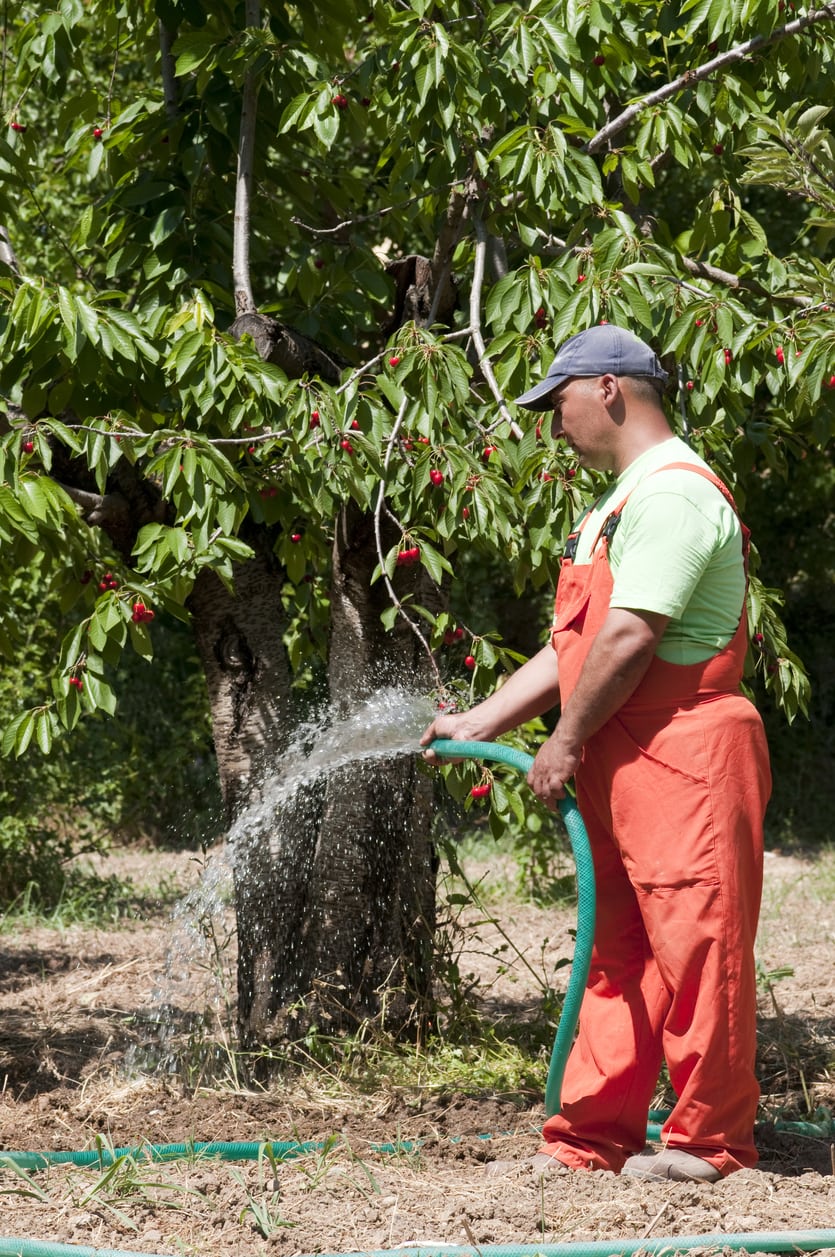Cherry Water Needs: Learn How To Water A Cherry Tree


Each year we look forward to the beautiful, fragrant cherry blossoms which seem to scream, “spring has finally come!” However, if the previous year was extremely dry or drought-like, we may find our spring cherry blossom display lacking. Likewise, an extremely wet growing season can also cause significant problems with cherry trees. Cherry trees can be very particular about their watering needs; too much or too little water can have drastic effects on the tree. Continue reading to learn how to water a cherry tree.
About Cherry Tree Irrigation
Cherry trees grow wild throughout much of the United States. In the wild, they easily establish in sandy-loam or even rocky soils but struggle in heavy clay soils. This is true for the home garden and orchards as well. Cherry trees require excellent draining soil to grow, blossom, and fruit properly. If soil is too dry or cherry trees experience drought stress, leaves can curl, wilt, and drop. Drought stress can also cause cherry trees to produce less blossoms and fruit or lead to stunted tree growth. On the other hand, waterlogged soils or over-irrigation can lead to all sorts of nasty fungal diseases and cankers. Too much water can also suffocate cherry tree roots, causing stunted trees that don’t bloom or set fruit and can ultimately lead to plant death. More cherry trees die from too much water than too little. That’s why learning more about cherry tree watering is so important.
Tips for Watering Cherry Trees
When planting a new cherry tree, it is important to understand cherry water needs to get the tree off to a good start. Prepare the site with soil amendments to ensure the soil drains well but will not be too dry. After planting, watering cherry trees properly their first year is extremely important. They should be watered the first week every other day, deeply; the second week they can be watered deeply two to three times; and after the second week, water cherry trees thoroughly once a week for the rest of the first season. Adjust watering as needed in times of drought or heavy rainfall. Keeping weeds pulled around the base of cherry trees will help ensure that the roots get the water, not the weeds. Putting mulch, like wood chips, around the cherry tree root zone will also help retain soil moisture. Established cherry trees rarely need to be watered. In your region, if you receive at least an inch (2.5 cm.) of rain every ten days, your cherry trees should be receiving adequate water. However, in times of drought, it is important to provide them with some extra water. The best way to do this is to place the hose end directly on the soil above the root zone, then let the water run at a slow trickle or light stream for about 20 minutes. Make sure all the soil around the root zone is thoroughly wet. You can also use a soaker hose. The slow stream of water gives the roots time to soak up the water and prevents wasted water from runoff. If drought persists, repeat this process every seven to ten days.
Gardening tips, videos, info and more delivered right to your inbox!
Sign up for the Gardening Know How newsletter today and receive a free copy of our e-book "How to Grow Delicious Tomatoes".
-
 Moody Blooms For Spring: 8 Types Of Black Flowers To Add Drama To Spring Displays
Moody Blooms For Spring: 8 Types Of Black Flowers To Add Drama To Spring DisplaysFrom midnight burgundies to inky violets, several types of black flowers can enrich and embolden a spring display. Try these brooding bloomers for a moody garden
By Tonya Barnett
-
 Can Snake Plants Live Outside? Everything You Need To Know For Snake Plants Al Fresco
Can Snake Plants Live Outside? Everything You Need To Know For Snake Plants Al FrescoSnake plants can live outside given the right conditions, but be careful that they don't take over! Learn the best way to use snake plants in your landscape.
By Mary Ellen Ellis